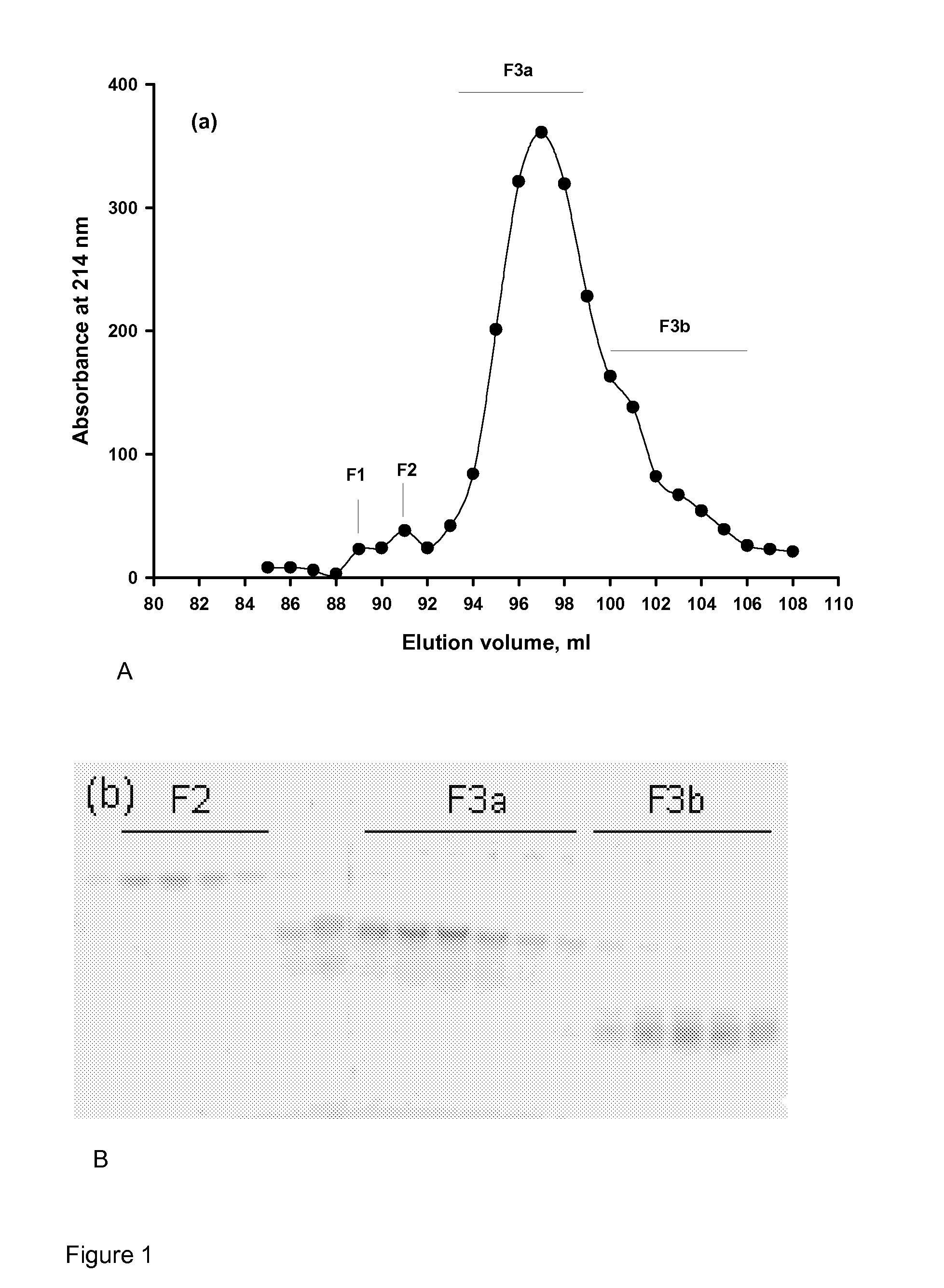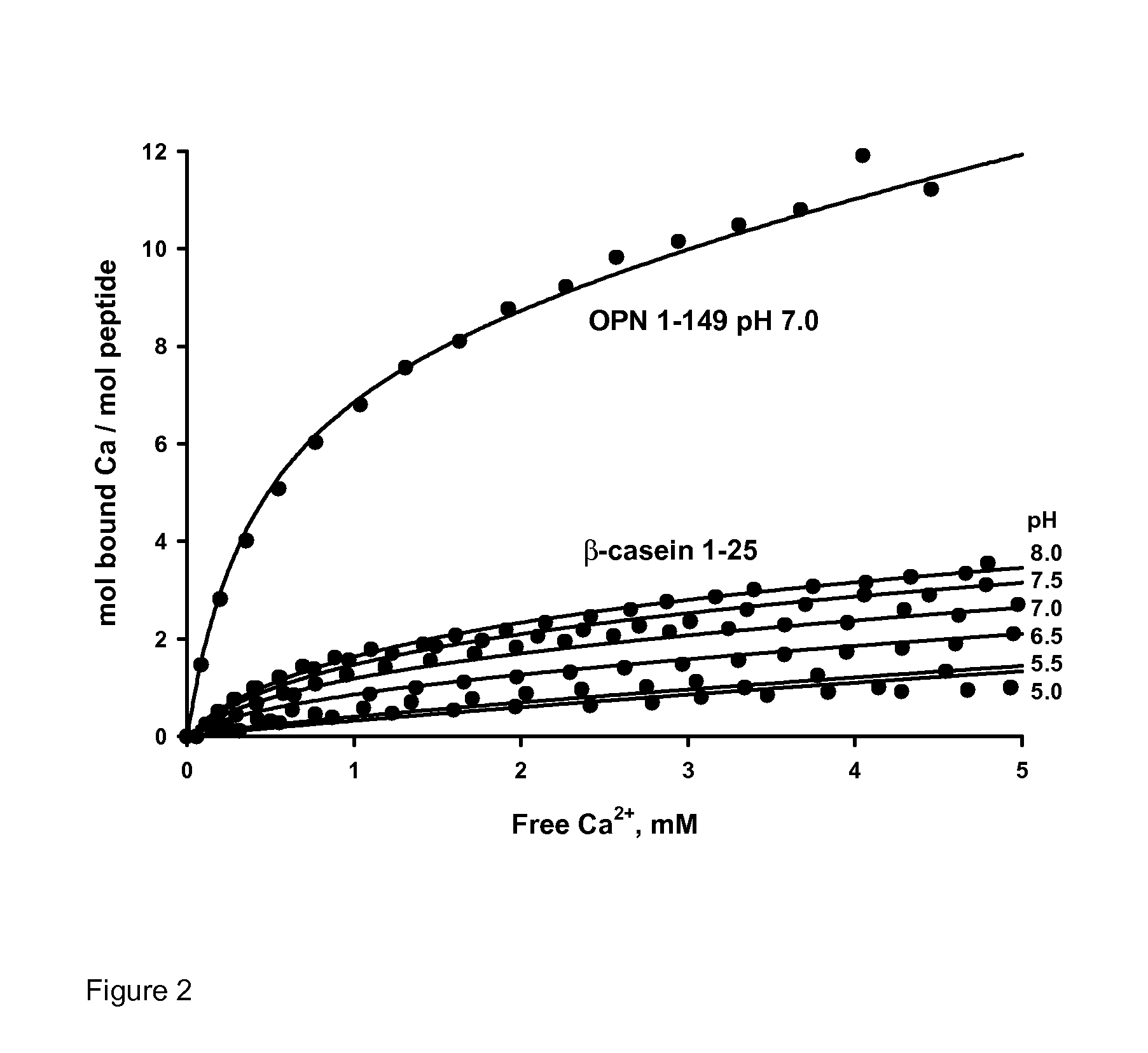Phosphopeptides and use of the same
a technology of phosphopeptides and nanoclusters, which is applied in the field of thermodynamically stable calcium phosphate nanoclusters, to achieve the effect of increasing the core size and increasing the amount of amorphous calcium phospha
- Summary
- Abstract
- Description
- Claims
- Application Information
AI Technical Summary
Benefits of technology
Problems solved by technology
Method used
Image
Examples
example 2
Preparation of Calcium Phosphate Nanoclusters
[0140]Nanoclusters were prepared by the urea / urease method, as discussed above and as known in the art (Holt, C., Wahlgren, N. M. & Drakenberg, T. (1996). Ability of a beta-casein phosphopeptide to modulate the precipitation of calcium phosphate by forming amorphous dicalcium phosphate nanoclusters. Biochemical Journal 314, 1035-1039) but wherein the phosphopeptide was provided by either the OPNmix, discussed above, or fractions from the gel filtration separation. Typically, an OPNmix sample (25 mg) was dissolved in 1 ml of water and dialysed overnight against 500 ml of 1 mM EDTA followed by exhaustive dialysis against deionised water to remove Ca ions. The Ca-free peptides were recovered by freeze drying.
[0141]An initial under-saturated solution of salts at pH 5 with the composition 22 mM Ca(NO3)2, 20 mM KH2PO4, 36 mM KNO3 and 1.5 mM NaN3 (Mg-free Buffer A) was used to dissolve the peptide. Sufficient urea (0-30 mM) was...
example 3
Partition of Salts by Ultrafiltration
[0144]Nanocluster solutions of the Ca-free OPNmix in the Mg-free Buffer A were prepared by the urea / urease method with a pH between 5.0 and 7.5. They were allowed to equilibrate before ultrafiltration through Vivaspin 0.5 ml concentrators (Product VS0101 with a molecular weight cut off of 10,000 Da, Vivascience AG, Germany) using a centripetal field of 5000×g for 15 min. The concentrations of Ca, free Ca2+, and P, in the ultrafiltrate and starting solution were determined (Little, E. M. & Holt, C. (2004). An equilibrium thermodynamic model of the sequestration of calcium phosphate by casein phosphopeptides. European Biophysics Journal with Biophysics Letters 33, 435-447). The concentrations of complexed Pi and Ca, [Pi]c and [Ca]c, respectively, were calculated from the difference between the total and ultrafiltrate concentrations after allowing for a Donnan equilibrium of each diffusible ion species across the semi-permeable membrane (Holt, C. (1...
example 4
Binding of Calcium Ions to OPN 1-149
[0145]To model the chemical species in the OPN 1-149 nanocluster solution requires the calculation of Ca ion binding to the free peptide at any pH in the range 5.0-8.0. A semi-empirical model was used to describe the binding isotherms obtained previously for the β-casein 1-25 phosphopeptide in this pH range and the same model was adapted to fit the binding isotherm of OPN 1-149 measured at pH 7.0. The rescaled model was then used to predict binding at any other value of the pH. Binding of Ca ions to the β-casein 1-25 peptide is predominantly to 4 phosphorylated residues and, to a lesser extent, to 7 Glu residues and the C-terminus.
[0146]Fitting of the experimental isotherms was done to an equation of the form
υ_Ca=∑iϕiNi(pH)Ka,i[Ca2+](1+Ka,i[Ca2+])(11)
where the summation is over all binding sites with Ca ion association constants Ka,i. The function Ni(pH) describes the number of sites of type i as a function of pH and φi is the degree of phosphoryl...
PUM
| Property | Measurement | Unit |
|---|---|---|
| surface area | aaaaa | aaaaa |
| core radius | aaaaa | aaaaa |
| modal radius | aaaaa | aaaaa |
Abstract
Description
Claims
Application Information
 Login to View More
Login to View More - R&D
- Intellectual Property
- Life Sciences
- Materials
- Tech Scout
- Unparalleled Data Quality
- Higher Quality Content
- 60% Fewer Hallucinations
Browse by: Latest US Patents, China's latest patents, Technical Efficacy Thesaurus, Application Domain, Technology Topic, Popular Technical Reports.
© 2025 PatSnap. All rights reserved.Legal|Privacy policy|Modern Slavery Act Transparency Statement|Sitemap|About US| Contact US: help@patsnap.com



